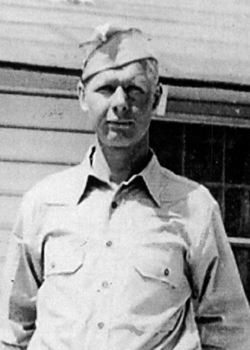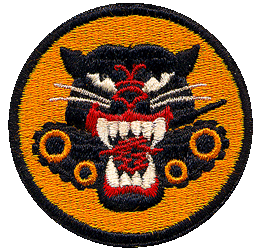 Henry H. Probst
Henry H. Probst
Biography: Henry H. “Hank” Probst was born on May 5, 1919 in Sterling, Nebraska. He was the son of Otto Probst and Emman Grundman and attended Sterling High School. He went on to attend the University of Nebraska for business and later found work at a sugar beet factory in western Nebraska.
Service Time: Hank entered the service on February 25, 1942, and was assigned to the Reconnaissance Company of the 636th Tank Destroyer Battalion. The unit trained at a number of military facilities including Camp Blanding, St. Augustine, Florida and Camp Edwards, Massachusetts. The 636th was stationed there from October 1942 to February 1943. From Camp Edwards, the unit traveled to the A.P. Hill Military Reservation in Virginia and then moved to the New York port where they would ship out on April 2, 1943.
They arrived at Oran, Algeria, on April 13, 1943, and then boarded ships again, landing at Paestum, Italy, beginning on September 13th. Elements performed artillery missions, guarded the Fifth Army Command Post, and trained British troops on the M10 Tank Destroyer and TD doctrine in October and November. The 636th reentered the line at the Mignano sector in late November, supporting the assault on San Pietro and later the Rapido River crossing in January, 1944.
It was during the Rapido (actually the Gari River) crossing that Hank would distinguish himself. The crossing was designed to break through enemy lines that had stalled the Allied advance deeper into Italy. Heavy losses of personnel from the 141st and 143rd Infantry Regiments were experienced as they crossed the river and tried to hold a beachhead. Hank was assisting the liaison officer of the 141st, who was probably directing support fire, to hit enemy targets across the river. The crossing was done under heavy artillery, mortar and small arms fire and the liaison party was forced to setup a observation post in an irrigation ditch. Hank recrossed the river on an extremely hazardous foot-bridge experiencing the same intense fire as they had seen on the initial crossing. After the Liaison officer was killed by a mortar shell, Henry and another enlisted man took over the liaison duties to support the troops until ordered to return to their unit. For his actions, Hank was awarded the Bronze Star for Gallantry in Action.
Bronze Star Citation – The Sterling Sun, Sunday August 3, 1944
The 636th then entered the Cassino sector in February and transferred to the Anzio beachhead in May, entering Rome on June 4th. They boarded ships again and landed in Southern France on August 15th and were the first unit to enter Lyon and reach the Moselle River in September. Engaged in the Vosges Mountain region beginning in October, they relieved the 601st TD Bn in Strasbourg in December and battled the German Northwind offensive in January and February, 1945. Converting to M36 Tank Destroyers, beginning in late February they struck the Siegfried Line defenses near Wissembourg in late March and crossed the Rhine with the 14th Armored Division in April. The 636th finally dashed toward Nürnberg and ended the war in southern Bavaria near Tegernsee.
At the very end of the war, Hank and a few members of his unit were sent to oversee the surrender of Reichsmarschall Hermann Goering. The mission took them behind enemy lines and into Fischhorn Castle, which was located in Austria. Hank and Lester Leggett, also of Recon. Company were on hand when Goering surrendered to 36th Infantry Division Commander, Brig. Gen. Robert I. Stack. It was a long night between May 7th and 8th of 1945, with American, SS and Luftwaffe soldiers at the castle and all armed and anxious. Thankfully, all went smoothly. Additional information on this mission can be found in an interview with Lester Leggett by David Lesjak of World War II Magazine (June 12, 2006). The interview mentions Hank, who was acting First Sergeant and mentions that he was the first of the group to enter the castle. Article link is shown below:
Mission to Capture Hermann Goering

The unit saw action throughout Europe and Hank received credit for five campaigns including, Naples – Foggia, Rome – Arno, Northern France, Southern France, Rhineland and Central Europe. He earned a Bronze Star and the Good Conduct Medal as well as the EAME Theater Medal with Arrowhead device denoting the unit’s amphibious assault during the Southern France campaign. Although offered a field promotion to Lieutenant, he choose to leave the service on September 25, 1945, at the rank of Staff Sergeant.
The photo on left shows a Nazi flag taken during the 36th Infantry Division’s invasion of Salerno, Italy. The occasion was a reunion of the 636th in August of 1979. Hank is standing in the center of the back row and is the tallest man there. The flag had been brought home by Hank was in the possession of the Probst family over the years. The men shown are fellow members of the 636th.
When Hank returned to the U.S., he worked for Firestone initially at South Sioux City, NE and then in Falls City before going into farming in 1952. On Sept. 11, 1949, he married the former Verla May Kupke who was born in Greenwood, NE and was the daughter of Carl Kupke and Sarah Lau. The couple had one son, Steven, and made their home in Cook, NE. Hank was a member of the VFW and Grace Lutheran Church in Cook.
Hank passed away on June 2, 2000, and was buried in the Grace Lutheran Church Cemetery in Cook, NE. At the time of his death, he had three grandchildren, Jennifer, Jill and Joseph from his son Steve and his wife Diane. I want to thank Hank’s son Steve for providing this information and photo of his father. Thank you also to Alex Drury for providing additional information.
